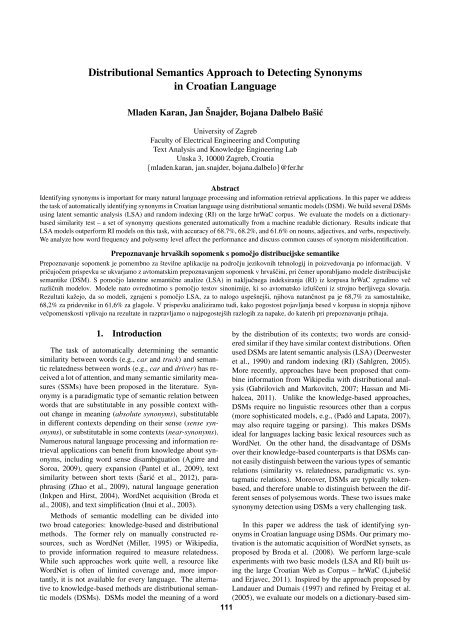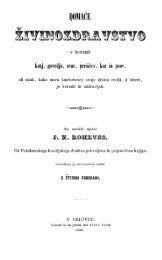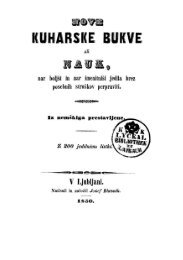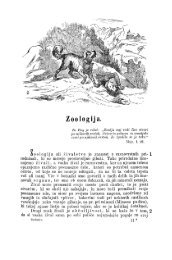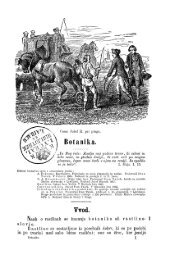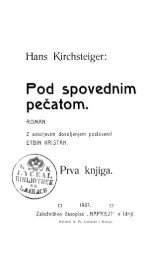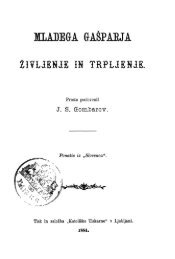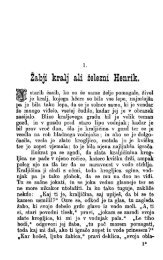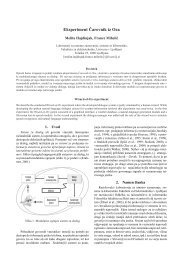Proceedings - Natural Language Server - IJS
Proceedings - Natural Language Server - IJS
Proceedings - Natural Language Server - IJS
You also want an ePaper? Increase the reach of your titles
YUMPU automatically turns print PDFs into web optimized ePapers that Google loves.
Distributional Semantics Approach to Detecting Synonyms<br />
in Croatian <strong>Language</strong><br />
Mladen Karan, Jan ˇSnajder, Bojana Dalbelo Baˇsić<br />
University of Zagreb<br />
Faculty of Electrical Engineering and Computing<br />
Text Analysis and Knowledge Engineering Lab<br />
Unska 3, 10000 Zagreb, Croatia<br />
{mladen.karan, jan.snajder, bojana.dalbelo}@fer.hr<br />
Abstract<br />
Identifying synonyms is important for many natural language processing and information retrieval applications. In this paper we address<br />
the task of automatically identifying synonyms in Croatian language using distributional semantic models (DSM). We build several DSMs<br />
using latent semantic analysis (LSA) and random indexing (RI) on the large hrWaC corpus. We evaluate the models on a dictionarybased<br />
similarity test – a set of synonymy questions generated automatically from a machine readable dictionary. Results indicate that<br />
LSA models outperform RI models on this task, with accuracy of 68.7%, 68.2%, and 61.6% on nouns, adjectives, and verbs, respectively.<br />
We analyze how word frequency and polysemy level affect the performance and discuss common causes of synonym misidentification.<br />
Prepoznavanje hrvaˇskih sopomenk s pomočjo distribucijske semantike<br />
Prepoznavanje sopomenk je pomembno za ˇstevilne aplikacije na področju jezikovnih tehnologij in poizvedovanja po informacijah. V<br />
pričujočem prispevku se ukvarjamo z avtomatskim prepoznavanjem sopomenk v hrvaˇsčini, pri čemer uporabljamo modele distribucijske<br />
semantike (DSM). S pomočjo latentne semantične analize (LSA) in naključnega indeksiranja (RI) iz korpusa hrWaC zgradimo več<br />
različnih modelov. Modele nato ovrednotimo s pomočjo testov sinonimije, ki so avtomatsko izluˇsčeni iz strojno berljivega slovarja.<br />
Rezultati kaˇzejo, da so modeli, zgrajeni s pomočjo LSA, za to nalogo uspeˇsnejˇsi, njihova natančnost pa je 68,7% za samostalnike,<br />
68,2% za pridevnike in 61,6% za glagole. V prispevku analiziramo tudi, kako pogostost pojavljanja besed v korpusu in stopnja njihove<br />
večpomenskosti vplivajo na rezultate in razpravljamo o najpogostejˇsih razlogih za napake, do katerih pri prepoznavanju prihaja.<br />
1. Introduction<br />
The task of automatically determining the semantic<br />
similarity between words (e.g., car and truck) and semantic<br />
relatedness between words (e.g., car and driver) has received<br />
a lot of attention, and many semantic similarity measures<br />
(SSMs) have been proposed in the literature. Synonymy<br />
is a paradigmatic type of semantic relation between<br />
words that are substitutable in any possible context without<br />
change in meaning (absolute synonyms), substitutable<br />
in different contexts depending on their sense (sense synonyms),<br />
or substitutable in some contexts (near-synonyms).<br />
Numerous natural language processing and information retrieval<br />
applications can benefit from knowledge about synonyms,<br />
including word sense disambiguation (Agirre and<br />
Soroa, 2009), query expansion (Pantel et al., 2009), text<br />
similarity between short texts (ˇSarić et al., 2012), paraphrasing<br />
(Zhao et al., 2009), natural language generation<br />
(Inkpen and Hirst, 2004), WordNet acquisition (Broda et<br />
al., 2008), and text simplification (Inui et al., 2003).<br />
Methods of semantic modelling can be divided into<br />
two broad categories: knowledge-based and distributional<br />
methods. The former rely on manually constructed resources,<br />
such as WordNet (Miller, 1995) or Wikipedia,<br />
to provide information required to measure relatedness.<br />
While such approaches work quite well, a resource like<br />
WordNet is often of limited coverage and, more importantly,<br />
it is not available for every language. The alternative<br />
to knowledge-based methods are distributional semantic<br />
models (DSMs). DSMs model the meaning of a word<br />
111<br />
by the distribution of its contexts; two words are considered<br />
similar if they have similar context distributions. Often<br />
used DSMs are latent semantic analysis (LSA) (Deerwester<br />
et al., 1990) and random indexing (RI) (Sahlgren, 2005).<br />
More recently, approaches have been proposed that combine<br />
information from Wikipedia with distributional analysis<br />
(Gabrilovich and Markovitch, 2007; Hassan and Mihalcea,<br />
2011). Unlike the knowledge-based approaches,<br />
DSMs require no linguistic resources other than a corpus<br />
(more sophisticated models, e.g., (Padó and Lapata, 2007),<br />
may also require tagging or parsing). This makes DSMs<br />
ideal for languages lacking basic lexical resources such as<br />
WordNet. On the other hand, the disadvantage of DSMs<br />
over their knowledge-based counterparts is that DSMs cannot<br />
easily distinguish between the various types of semantic<br />
relations (similarity vs. relatedness, paradigmatic vs. syntagmatic<br />
relations). Moreover, DSMs are typically tokenbased,<br />
and therefore unable to distinguish between the different<br />
senses of polysemous words. These two issues make<br />
synonymy detection using DSMs a very challenging task.<br />
In this paper we address the task of identifying synonyms<br />
in Croatian language using DSMs. Our primary motivation<br />
is the automatic acquisition of WordNet synsets, as<br />
proposed by Broda et al. (2008). We perform large-scale<br />
experiments with two basic models (LSA and RI) built using<br />
the large Croatian Web as Corpus – hrWaC (Ljubeˇsić<br />
and Erjavec, 2011). Inspired by the approach proposed by<br />
Landauer and Dumais (1997) and refined by Freitag et al.<br />
(2005), we evaluate our models on a dictionary-based sim-


